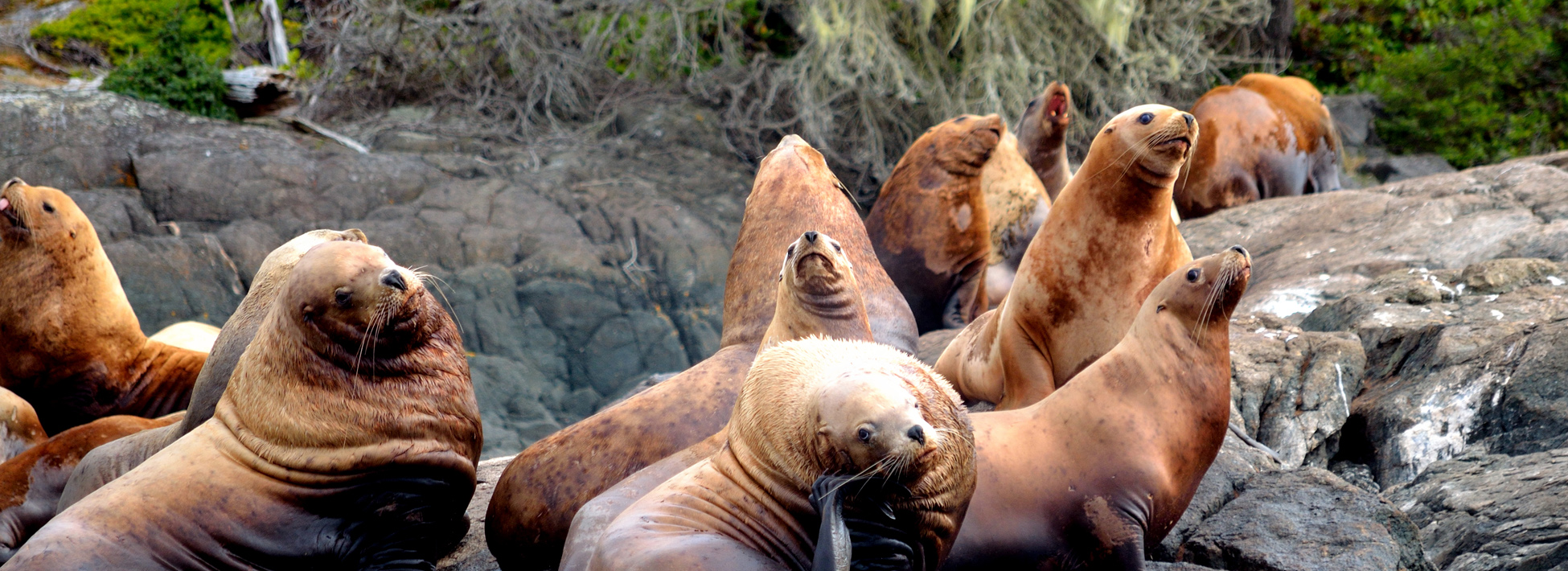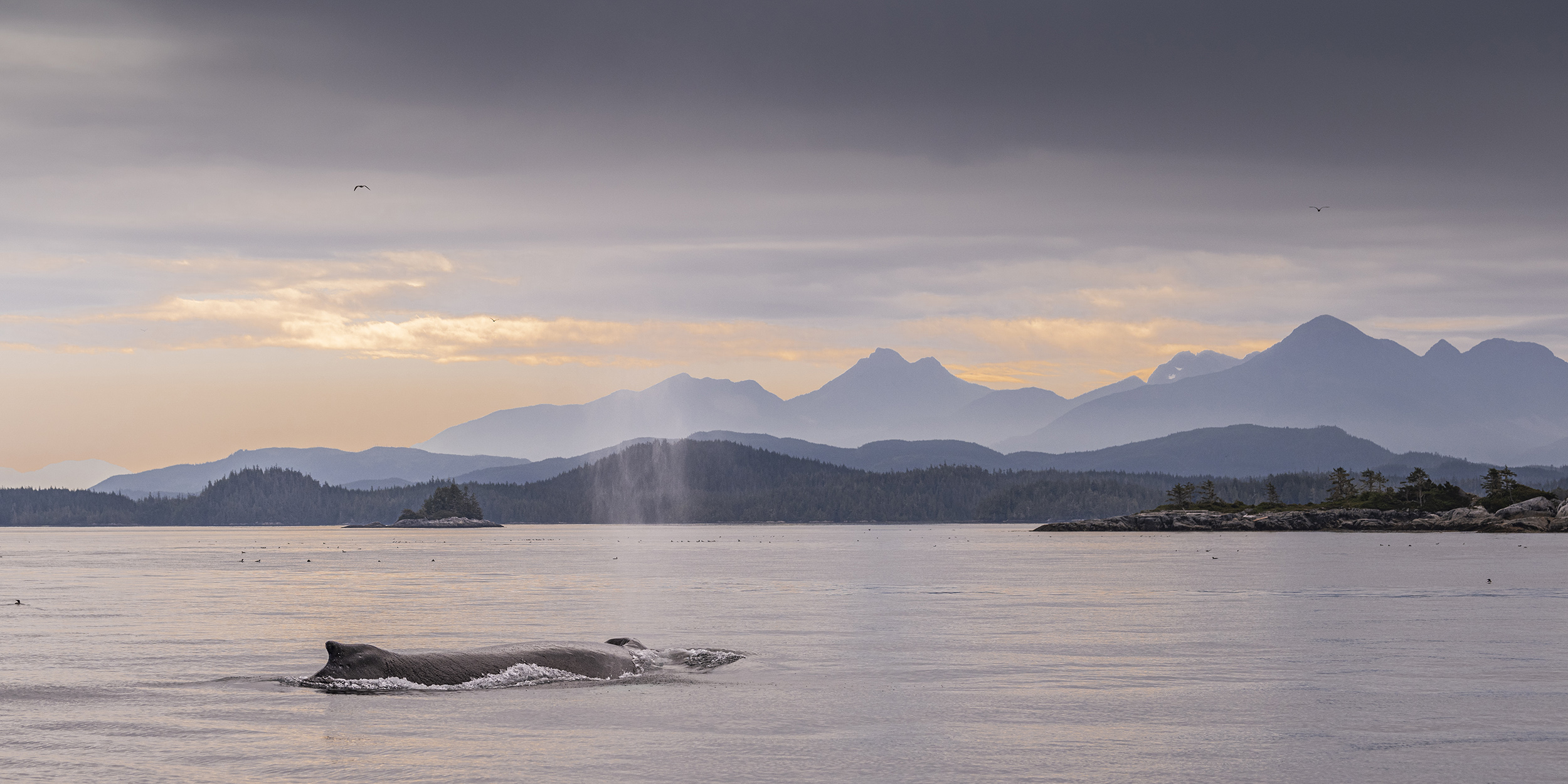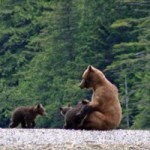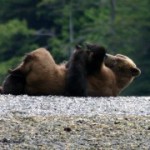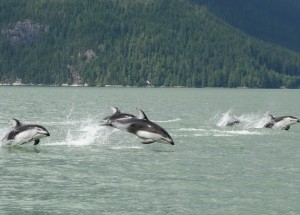Click photo to enlarge
Grizzly Bear and Wildlife Viewing Blog: Monthly Archives: May 2013
Spring Grizzly Bear and Cub

This photo of a “long legged” grizzly bear was taken in the spring. As the season progresses and the bears bulk up for the fall hibernation their legs seem to get shorter and shorter. Bears may loose 15-30 % of their body weight during hibernation giving the appearance of longer legs. The cub behind the mother appears, by it’s size, to be last year’s cub. Cubs normally spend two years with their mother and if she does not become pregnant may be with her for a third season. The Glendale River estuary, our grizzly viewing area, provides a good beach at low tide to for “beach food” which is important as berries are relatively scarce and as the salmon have not arrived in the rivers bears will continue to loose weight until well into June.
Classic orca photo
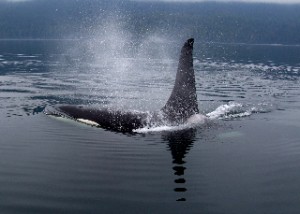
The whale / orca watching safari day from Grizzly Bear Lodge start with a fifty minute boat ride from the lodge to the area of Johnstone Strait. Along the way we search the shore for black bears, eagles and anything else that moves. Once we are in the Strait’s area or eyes turn to the water for marine wildlife such as seals, sea lions, dall’s porpoise, white-sided dolphins, minkie whales, humpback whales and of course killer whales or orca. The resident or salmon eating orca we normally see in this area travel in family pods of ten to twenty members. The pods are dominated by the “mother” (oldest female) making them matriarchal however it is older males (sons stay with their mother all their life) that tend to attract most of the picture taking.
Grizzly and deer grazing
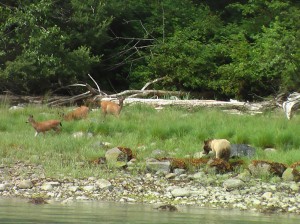
This is not an unusual scene in the spring at the river estuary in Knight Inlet. The grizzly bears come into the estuary at low tide to turn over rocks to gather the small invertebrates for the protein they contain. Another favourite food this time of the year is sedge grass which is very high in protein and as the salmon have not arrived the beach is the grizzlies’ main source of food until the many variety of berries start to ripen in mid-June. Not to be out done the deer also need to eat and sedge grass also provides them with a necessary source of food. The deer are always alert and keep an eye on the bears but I have never seen a bear attempt a chase. The level beach area gives the deer an advantage and the openness prevents a surprise attack by the bears.
Spring grizzly bear teaching cub

One of the best ways to learn is to watch another and this is true of grizzly bears as it is of humans. This mother grizzly in the Glendale River estuary of Knight Inlet is teaching by example. At low tide especially in the spring when the salmon have not arrived in the river to spawn will bring the grizzly to the beach. The turning over rock produces food high in protein, which is made up of crab, clams, barnacles, amphipods and other tiny invertebrates. This cub is ready to share moms food and will soon be turning it’s own rock in search of a meal.
Humpback Whale mother and calf
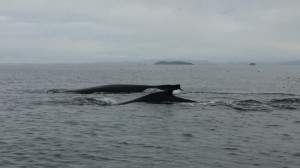 For the past five years the number of humpback whales spending their summers in our viewing area has increased to eight to ten whales viewed on a daily basis. The southern BC/Washington population, which includes our area, is approximately 200-400 whales. It is becoming more common to see calves with their mothers. The gestation period is approximately 11 months, calves being born between December and April. A calf will spent about one year with its mother before becoming independent. Our viewing area is rich in herring and therefore a feeding area for the calves and mothers. There also appears to be a correlation between feeding and breeding grounds. The majority of humpback whales feeding in the southern BC waters have been re-sighted off mainland Mexico, as well as Hawaii according to the B.C. Cetacean Sighting Network.
For the past five years the number of humpback whales spending their summers in our viewing area has increased to eight to ten whales viewed on a daily basis. The southern BC/Washington population, which includes our area, is approximately 200-400 whales. It is becoming more common to see calves with their mothers. The gestation period is approximately 11 months, calves being born between December and April. A calf will spent about one year with its mother before becoming independent. Our viewing area is rich in herring and therefore a feeding area for the calves and mothers. There also appears to be a correlation between feeding and breeding grounds. The majority of humpback whales feeding in the southern BC waters have been re-sighted off mainland Mexico, as well as Hawaii according to the B.C. Cetacean Sighting Network.
Black bear on a grizzly tour
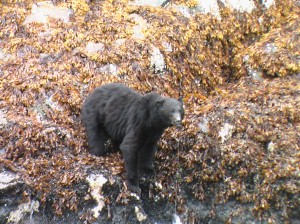
The day tour up Knight Inlet from Grizzly Bear Lodge is about an hour run to the Glendale River estuary an area frequented by grizzly bears. On this run it is common to see black bears coming to the shore eat the barnacles and muscles exposed by the low tide. Some of these bears are patient or maybe to interested in food and ignore our boat stopping for pictures other disappear as soon as we slow down. The younger bears tend to run the older bears have accepted the intrusion and realize there is no danger.
Sea lions on whale watching safari
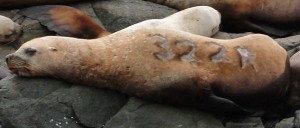
Steller sea lions often “haul out” on the rocks near Stubs Island located not far from Telegraph Cove on Vancouver Island. They pass through this area in the spring and fall traveling between California and Alaska. The sea lion numbers are on a decline along the West Coast of North America and a branding identification program has been underway for about fifteen years. “The two sites chosen to mark Steller pups were Pyramid Rock at Rogue Reef, Oregon and Southwest Seal Rock at St. George Reef in northern California. These sites are the largest Steller sea lion rookeries in the lower forty eight states. Steller sea lion pups were branded along the left flank. Sea lions branded at Rogue Reef, Oregon have a letter R following the numbered digit (i.e. 25R). Quote from Patrick J. Gearin
NOAA, AFSC, National marine Mammal Laboratory” Several of these branded sea lions are seen each summer and sightings are reported.
Guest question about grizzly bears
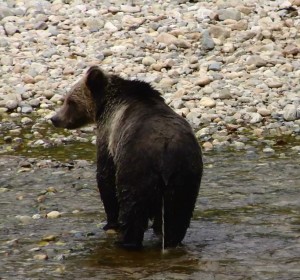
An often asked questions from the guests a Grizzly Bear Lodge is: Is that a male or female grizzly? Some guidelines we use to go by are: The male is usually bigger and his head appears to be smaller in comparison to his body. Females appear to have shorter legs and are a bit more squat in appearance. The body difference is often hard to determine unless there are several grizzlies together. And of course in the spring when they have not had time to fatten on the salmon it may be even harder to determine the difference. In the May and June the mating season the male has a swagger, often walking with a swaying walk with their hind legs farther apart than normal. The tried and true way to tell the males from the females (as shown in this picture) is to watch them urinate. The males urinate forward, and the females backward! This picture also reinforces something I was told by a friend who spends allot of time in the bush “If you take a drink of water from a river or stream do not walk up river and look around he corner.”
Whale watching safari
On the whale watching day we frequently encounter pacific white side dolphins. The area along BC’s coast between Vancouver Island and the mainland has become a feeding area for the dolphins. Until twenty years ago they rarely appeared in fact so rare that native people did not have a name for them in their language. Now these dolphins are becoming more common in our viewing area. We see pods of several hundred.
